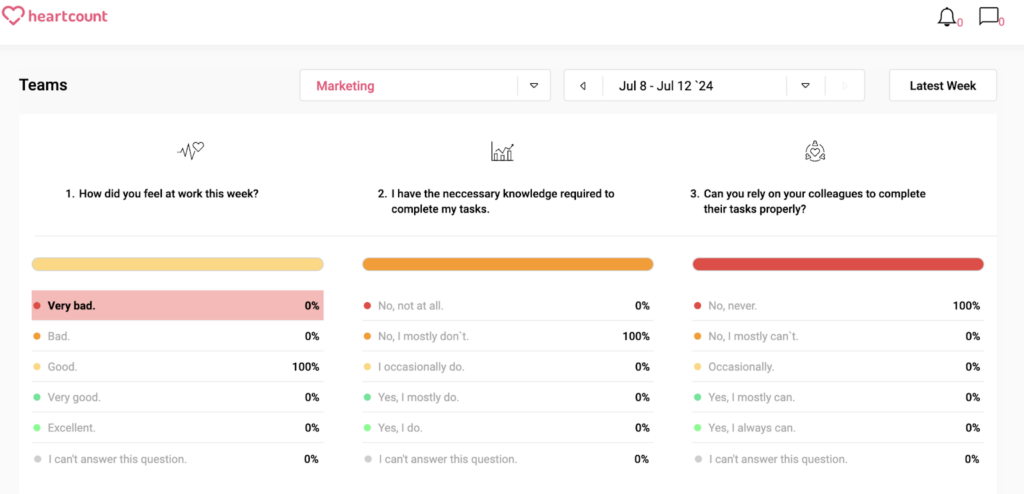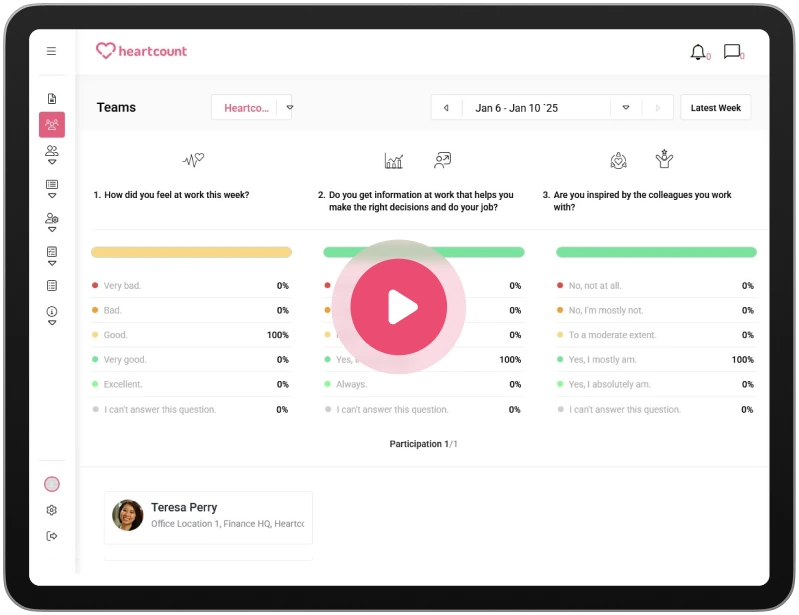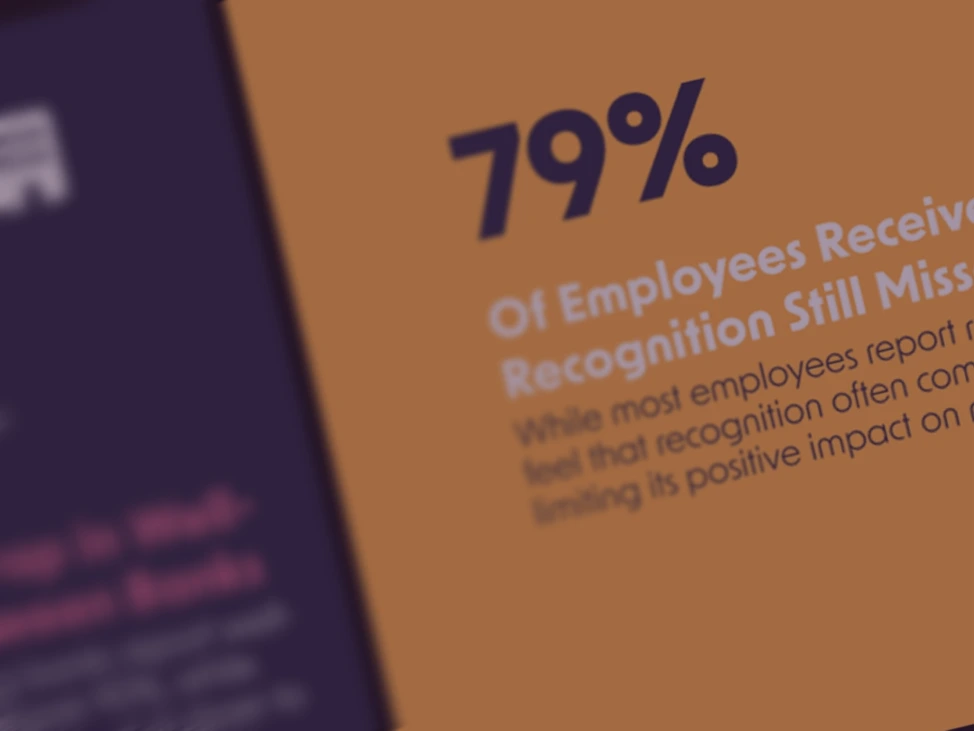Employee Experience vs. Employee Engagement: Understanding the Difference and the Connection

Do you ever find yourself wondering whether to focus on employee experience or employee engagement in your HR strategy?
While these concepts are related, they’re not the same, so overlooking one for another can be detrimental. For example, you might have employees who enjoy positive work experiences but are still disengaged or employees who are highly engaged despite a negative experience (though this is often short-lived).
To truly succeed, it’s essential to look at employee experience vs employee engagement, understand how they are connected, and see how focusing on both can contribute to a thriving workplace.
-
1.What is employee experience?
-
2.What is employee engagement?
-
3.Employee Experience vs. Employee Engagement
-
4.The cycle of influence for employee experience vs employee engagement
-
5.Challenges in measuring and improving EX and EE
-
6.Tips for enhancing employee engagement and experience
-
7.Conclusion
Do you ever find yourself wondering whether to focus on employee experience or employee engagement in your HR strategy?
While these concepts are related, they’re not the same, so overlooking one for another can be detrimental. For example, you might have employees who enjoy positive work experiences but are still disengaged or employees who are highly engaged despite a negative experience (though this is often short-lived).
To truly succeed, it’s essential to look at employee experience vs employee engagement, understand how they are connected, and see how focusing on both can contribute to a thriving workplace.
What is employee experience?
Employee experience (EX) refers to all interactions and perceptions an employee has within a company, from the beginning to the end of their employment journey.
It encompasses the physical workspace, the tools and technology provided for their job, their relationships with coworkers and supervisors, and the overall company culture.
EX is the outcome of a conscious and strategic effort to create a supportive and engaging environment where employees feel valued and motivated.
Why is employee experience important?
A positive employee experience is vital for several reasons:
- Employee satisfaction and engagement. Imagine you’ve just implemented a personalized career development plan and recognition program, and a new hire, previously neglected in his old company, receives tailored training in areas he is passionate about. As a result, this employee feels valued and supported from the start. This positive experience leads to high satisfaction and strong engagement, boosting overall employee morale and productivity.
- Attraction and retention. Building on the same example, a positive employee experience doesn’t just make your new hire feel valued and satisfied but also turns him into a strong advocate for your company. This not only reduces turnover and increases retention but also attracts high-quality candidates eager to join your company.
- Business performance and customer experience. This positive experience also leads to higher quality work, faster project completion, and innovative solutions that improve client satisfaction. Engaged and satisfied employees deliver superior service and contribute to the company’s success.
Factors influencing employee experience
What the employee experience will look like at your company depends on many factors, from the environment in which the employees work to the relationships among team members.
- Work environment: The design and functionality of the physical workspace and the availability of tools and technology that facilitate efficient work.
- Company culture: The shared values, practices, and behaviors define the organization and influence how employees interact and work together.
- Leadership and management: The quality of leadership practices, including communication, support, feedback, and recognition.
- Professional development: Opportunities for employees to grow professionally and advance their careers within the organization.
- Recognition and rewards: Acknowledgement of employee contributions impact motivation and satisfaction.
- Work-life balance: Policies and practices that support employees in effectively managing their work and personal responsibilities.
What is employee engagement?
Employee engagement (EE) refers to the emotional commitment and sense of belonging employees have toward their organization and its goals. It shows how motivated and passionate employees are about their work and how much they are willing to go the extra mile to contribute to the organization’s success.
Engaged employees typically show high enthusiasm and dedication and are deeply invested in their work. They often go beyond the basic requirements of their job, demonstrating initiative and a strong desire to contribute to their team and company’s achievements.
Measuring employee engagement can be achieved through pulse checks, feedback mechanisms, and observing behaviors like productivity, attendance, and the quality of work.
Why is employee engagement important?
Employee engagement is crucial for several reasons that impact an organization’s overall success and health:
- Productivity: Imagine you have a highly engaged employee. He will put extra effort into his work and be more invested in company goals, leading to higher productivity. Research has proven this, so companies with high employee engagement achieve 22% higher productivity.
- Employee retention: High engagement levels are also linked to lower turnover rates. If your employees are engaged, they are less likely to leave the company. Companies with engaged employees see 59% less turnover, which is significant considering the high costs of recruiting and training new employees.
- Company culture: When employees are engaged, their morale is higher, and they feel well at work. This nurtures a positive company culture where everybody feels supported and appreciated. Such a culture attracts new talent and enhances collaboration and innovation, creating a dynamic and rewarding work environment.
- Customer satisfaction: Engaged employees are often more attentive, enthusiastic, and committed to providing the best service possible, directly impacting customer loyalty and profitability.
- Financial performance: Companies with high levels of engagement report 21% higher profitability. Engaged employees can contribute to your bottom line through improved productivity, efficiency, and customer service.
Factors influencing employee engagement
Key factors that contribute to how motivated, committed, and passionate employees are about their work and company include:
- Company culture: When your organization clearly communicates its values and beliefs and supports them through consistent actions, it shapes employee behaviors and perceptions. This leads to a more engaged workforce. Organizations with strong cultures see up to 72% higher employee engagement levels.
- Recognition: If your employees feel valued and recognized, they will be more motivated to work and contribute to the company’s success. Companies that excel in employee recognition are 12x likelier to generate strong business results.
- Growth opportunities: Access to training and career growth keeps employees motivated. 94% of employees would stay with a company that supports their career development.
- Work-life balance: Flexible work arrangements prevent overwork and lead to happier, more engaged employees. 87% of employees expect the company to support balancing their work and personal commitments.
- Employee voice: Being heard matters. Companies that effectively gather and act on employee feedback have engagement levels 2.5 times higher than those that don’t.
- Job security and fair pay: Competitive salaries and benefits increase employee engagement. They improve retention rates and help with long-term planning and cost savings, as a well-structured salary package can reduce turnover and hiring costs.
- Peer relationships: Friendships at work can boost engagement significantly. Employees with “work besties” are 7 times more likely to be engaged.
Employee Experience vs. Employee Engagement
When comparing employee experience to employee engagement, keep in mind that you need to focus on both. Think of employee engagement as the goal and employee experience as the process that leads to the goal. They differ in focus, scope, perspective, way to be measured, impact, responsibility, timeframe, and final outcome. Take a deeper look at the table below. It shows the main aspects in which employee experience and employee engagement differ.
| Aspect | Employee experience | Employee engagement |
| Focus | The entire journey an employee takes within a company, including every interaction from recruitment to departure. | The emotional commitment and connection an employee feels towards their job, colleagues, and the organization. |
| Scope | Broad includes every touchpoint an employee has with the company. | Narrower focuses on the enthusiasm and dedication an employee feels towards their work. |
| Perspective | Primarily perceived from the employee’s perspective | Considers both the employee’s and employer’s viewpoints (as employers shape EX) |
| Measurement | Surveys, interviews, and observational methods across various stages of employment. | Surveys and polls designed to gauge employee’s enthusiasm, motivation, and commitment. |
| Impact | Affects overall satisfaction, retention, and performance indirectly through the quality of the work environment. | Directly influences productivity, customer service, and organizational performance. |
| Responsibility | A collective effort involving every level of the organization, from HR to direct managers to senior leadership. | Often driven by direct managers through recognition, feedback, and development opportunities. |
| Timeframe | Long-term, focusing on the entire lifecycle of the employee within the organization. | Can vary, with efforts to boost engagement potentially having immediate to short-term effects. |
| Outcome | A holistic sense of well-being, satisfaction, and alignment with organizational values and goals. | Increased willingness to go above and beyond, loyalty, and a positive attitude towards the organization. |
The cycle of influence for employee experience vs employee engagement
Employee engagement and experience have a reciprocal relationship where they continuously feed into and improve each other.
A supportive work environment, access to the right tools, and a positive organizational culture characterize great employee experiences. They also include healthy relationships with peers and managers. With these experiences, employees are more likely to feel valued and engaged. The positive experience motivates them to invest more emotionally and intellectually in their work, leading to higher levels of engagement.
Engaged employees contribute to a positive employee experience. Their enthusiasm and commitment foster a culture of collaboration and innovation. They’re more inclined to offer constructive feedback, participate in initiatives to improve the workplace, and support their colleagues, enhancing the employee experience for everyone within the organization.
Challenges in measuring and improving EX and EE
While both Employee Experience and Employee Engagement are crucial for organizational success, effectively managing them requires overcoming several hurdles:
1. Differentiation and understanding
- Challenge: It can be difficult to distinguish between the entire employee lifecycle and interactions with their organization (EX) and their emotional commitment to their work and company (EE).
- Solution: Provide education and practical examples to leaders and HR teams to help them understand the nuances between EX and EE and ensure strategies are correctly targeted.
2. Gathering data
- Challenge: Collecting data that genuinely reflects how employees feel and what they need can be hard, especially if they’re uncomfortable sharing openly.
- Solution: Use a mix of employee engagement survey types, regular pulse checks, and anonymous feedback tools to gather a broad range of data.
For example, with HeartCount, you can gather real-time data through regular pulse checks but also provide your employees with a chance to share their feedback through custom surveys, direct messages, or comments.



Employee comments on the HeartCount platform
3. Analyzing data for insights
- Challenge: Sifting through the collected data and finding meaningful insights that can drive positive changes is challenging.
- Solution: Leverage advanced analytics tools and train HR personnel to identify actionable insights from the data, focusing on what will genuinely improve EX and EE.
With HeartCounts’ intuitive interface, you can easily analyze employees’ responses and gain insight into several categories of engagement, including employee well-being, personal advancement, job satisfaction, attitude towards the company, relationship with management, relationship with colleagues, productivity and efficiency, and feedback and recognition.

4. Implementing changes
- Challenge: Even when you know what needs to change, making those changes happen can be met with resistance, or you might struggle to find the resources.
- Solution: Use a structured approach to change, involving clear communication of benefits and small-scale pilot programs to demonstrate success before rolling out wider changes.
5. Continuous monitoring and improvement
- Challenge: EX and EE are always evolving, so keeping up with changes and continuously improving can be daunting.
- Solution: Build a culture that values ongoing feedback and rapid adaptation. Regularly review and adjust your employee experience strategy based on fresh data and feedback to align with employee needs.
Tips for enhancing employee engagement and experience
Here are some tips that can help you to adopt a holistic approach to enhance both, employee experience and employee engagement.
- Listening and responding: Regularly gather and act on employee feedback to improve the work environment and address concerns.
- Leadership and management training: Equipping leaders and managers with the skills to effectively support, motivate, and engage their teams.
- Personalized experiences: Recognizing employees’ needs and preferences and tailoring the EX to meet these diverse requirements.
- Recognition and employee rewards: Implementing meaningful recognition and rewards systems that acknowledge employees’ contributions, further boosting engagement.
- Professional development: Offering career and skill development opportunities, showing employees they are valued and have a future within the organization.
Note: In global teams, employees in various locations or countries may have different employee experiences depending on local management, available resources, and more. These differences can create gaps between workers and a lack of sense of belonging to a company, making collaboration difficult.
Establishing company policies that cover everything from the onboarding process to handling paid time off and providing the right tools for employees goes a long way in building an equitable employee experience. It also nurtures trust and data-driven decisions that help you remain objective, which in turn contributes to higher employee engagement.
Conclusion
Although not synonymous, employee engagement and experience share a common goal—a positive and supportive workplace where employees can develop and thrive.
To achieve this, companies should continuously listen to and act on employee feedback. Using platforms for employee experience and engagement can significantly facilitate that.
For example, HeartCount is an employee experience platform that measures eight employee engagement categories, allowing you to connect with the sentiments and needs of their workforce.
With HeartCount, you can make informed decisions based on genuine feedback, build a culture of conversation, sharing, and mutual support, and reduce employee turnover.
Start a free trial to learn more about our platform.








